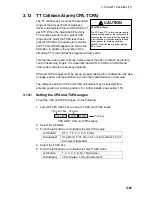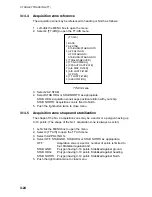
3. TARGET TRACKING (TT)
3-34
3.19 Factors
Affecting
TT
Functions
Sea returns
If the radar anti-clutter control is adjusted properly, there is no serious effect
because distant wave clutter, not eliminated by this control, is filtered out by
more than one bang correlation and scan-to-scan matching of data.
Rain and snow
Clutter can be acquired and tracked as targets. Adjust the A/C RAIN control. If it
is heavy rain, switch to S-band if provided, or switch on the interference rejector
on the radar. If heavy clutter still exists, switch to manual acquisition. Accuracy
can be affected.
Low clouds
Usually no affect. If necessary, adjust the A/C RAIN control.
Non-synchronous emissions
No effect.
Low gain
Insufficient or low radar receiver gain will result in some targets not being
acquired at long distance. TT display will be missing on one or more targets that
could only be visible if the radar sensitivity control (GAIN control) were
increased.
The setting of the correct radar receiver gain is not critical but the target should
be on the radar PPI and be clearly visible and well defined.
Manual acquisition is done if a target is positively displayed more than once.
Automatic acquisition is done when the target is detected 5-7 times continuously.
Tracking is achieved when the target is detected five times (not necessarily
continuously) out of 10 scans. If not detected six times out of 10 scans, the
target will become a "lost target." The TT will acquire a radar echo that is present
once in every six antenna scans and continue tracking if 1 in 10.
Second trace echoes
When the radar beam is super refracted, strong echoes may be received at such
long ranges that they appear on a different timebase sweep than the transmitted
pulse. This gives an incorrect range indication. Second and third trace echoes
can be tracked if they are consistent enough to meet acquisition and tracking
criteria but target course and speed data will be in error.
















































